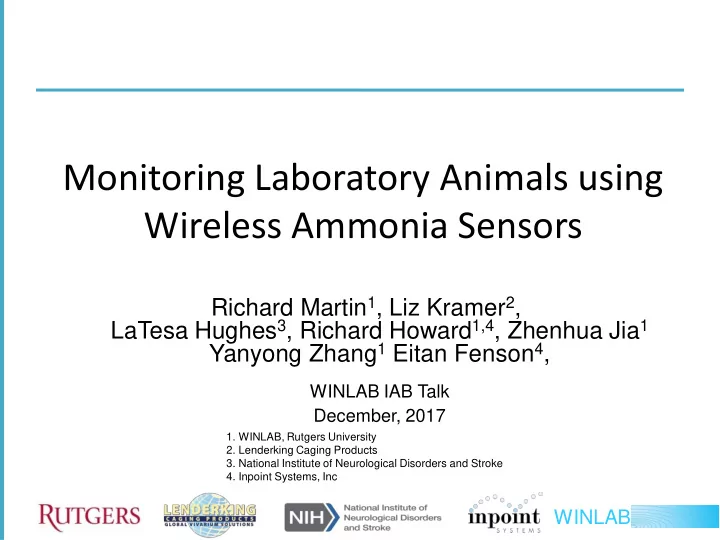

Monitoring Laboratory Animals using Wireless Ammonia Sensors Richard Martin 1 , Liz Kramer 2 , LaTesa Hughes 3 , Richard Howard 1,4 , Zhenhua Jia 1 Yanyong Zhang 1 Eitan Fenson 4 , WINLAB IAB Talk December, 2017 1. WINLAB, Rutgers University 2. Lenderking Caging Products 3. National Institute of Neurological Disorders and Stroke 4. Inpoint Systems, Inc WINLAB
Outline • Motivation • Background • Opportunities • Technical Challenges • Preliminary Trial Results • Conclusion WINLAB
Lab animals: pillars of science Biochemistry Biomedical Engineering Entomology Genetics Neuroscience Pathology Pharmacology Toxicology Psychology WINLAB
Rats & Mice The base of the pyramid 20-30 million used every year in the USA 8.25 million in the EU *Seventh Report on the Statistics of the Number of Animals Used for Experimental and other Scientific Purposes of the Member States of the European Union, 2011 WINLAB
Cages and Racks Ammonia Sensor Temperature, Light and Humidity Sensor WINLAB
Adding Sensing • Add electronic sensing to the cage environment • Today: Temperature, light, humidity, ammonia levels • Future: capacitive touch, cameras • Sensing enables: • Science at Scale • Reproducibility • Enhanced Animal Wellbeing • Improved Operations WINLAB
Sensor-based vision 200 250 Ammonia (ppm) 200 150 150 100 Sensed Data 100 50 50 0 0 -50 -50 Analysis Mice by % of time active MouseID % Time Active Cage M-673 52% 12 Reports and M-512 50% 45 Actuation Today’s Cage Changes Room Rack Cages IDs C112 5 10,12,18 C114 7 5,9,27 WINLAB
Outline • Motivation • Background • Opportunities • Science at Scale • Animal Wellbeing • Reproducibility • Operational improvements • Technical Challenges • Preliminary Trial Results • Conclusion WINLAB
Science at Scale • Science is labor intensive – Costly and Slow Identification • Sensing can reduce cost of many activities Growth & Development • Higher quality and quantity of observations • 10x-100x? Activity • Faster and Improved Quantification Science WINLAB
Reproducibility WINLAB
Animal Wellbeing Protocols & Ethics Policies Technology WINLAB
Operations: Performance-based cage changing • Calendar-based: • Change cages based on fixed schedule • Number of animals only factor • Performance-based: • Use in-cage sensing to schedule changes only when conditions require. • Reduced sensing costs makes performance approach feasible WINLAB
Why ammonia? • Produced by bacteria decomposing urea – High levels -> tissue damage • Ammonia level is one of several environmental metrics – No clear consensus • 25 and 50 PPM ammonia typical – based on human standards set by OSHA – Rodents can likely tolerate higher levels* *A. R. Green, C. M. Wathes, T. G M Demmers, J. MacArthur-Clark, H. Xin, Tolerance of atmospheric ammonia by laboratory mice , ASABE Annual International Meeting, 2006 WINLAB
Outline • Motivation • Background • Opportunities • Technical Challenges • Preliminary Trial Results • Conclusion WINLAB
Metal Oxide (MOX) Response Time to stabilize:120 seconds Can we reduce the time to heat the MOX film from 120 seconds to <600 ms? WINLAB
Challenge: MOX memory Sleep time cut by 2x, then reset to max WINLAB
Factors and Bayesian approach Fit to spline WINLAB
Outline • Motivation • Background • Opportunities • Technical Challenges • Preliminary Trial Results • Conclusion WINLAB
Cage Change Study • 5 female cull mice/cage • 30 Air Changes/Hour • 21 day cage change • Beddings: – Cellulose: BioFresh, Alpha Dri – Corn Cob: Shepard’s Specialty Blend, Bed O’Cobs – Wood: Beta Chip, Coarse Chips, 7086G • Ammonia measurement: – Handheld GX-6000, RKI • Front of cage modified with sampling port – Ammonia Sensors, InPoint Systems • Placed in food/water hopper 3 hour interval • Other parameters: body weight, temperature, relative humidity, CO 2 , bedding mass, moisture content of bedding, ATP in cage and on rack WINLAB
Using Cage Sensing • Detect an Alarm Condition: leaking water bottle • Vary change frequency based on number of mice • 21 day cycle for 5 mice • > 21 days possible for fewer mice – vs 1 or 2 week intervals as is practice • Quantify impact of different beddings WINLAB
Alarm Condition: Leaking Water Bottle 200 leak 150 InPoint Ammonia (ppm) RKI 100 Diurnal Variation 50 0 -50 0 3 7 10 14 17 21 Days after cage change WINLAB
Comparing number of mice 60 50 Ammonia (ppm) 40 30 20 10 0 4/30/2017 0:00 5/5/2017 0:00 5/10/2017 0:00 5/15/2017 0:00 5/20/2017 0:00 5/25/2017 0:00 5/30/2017 0:00 1 mouse 2 mice 4 mice 5 mice WINLAB
300 250 Ammonia(PPM) 200 150 100 50 0 Study progressed best performing beddings into next phases. Sample number not the same in each category: Paper n=68, Corn cobb n=24, wood n=8 WINLAB
Conclusions • Data revolution possible applying sensing to laboratory animals – Better balance: • Science, animal wellbeing, human convenience • Future Directions: • Enhanced scientific outcomes • Algorithms for alarms, prediction and reporting • Mandated data disclosures? WINLAB
Recommend
More recommend